Check out the NEW BEYOND REVOLUTION!!!
The anarchist urban ecosystem: A rethinking of the urban environment (part two)
By Nathan Revercomb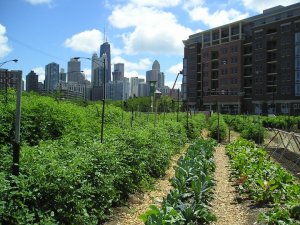
In this second installment of my series on the anarchist urban ecosystem, I will be taking a look at food production in a sustainable anarchist urban environment.
AGRICULTURE IN THE CITY
Food systems are integral to the support of cities and indeed are vital to living things including people. Modern food production in the form of industrial agriculture is incredibly destructive and inefficient. There is a great waste of resources in the form of fuel, time, and other inputs with relation to the rural based corporate farming model. However, those are not the only problems with monocutlural food production.

Industrial monoculture farming requires vast resources to produce food. Note the dust kicked up by the machines which is lost soil.
Deforestation which is a very key cause in soil loss through erosion is the result of the clearing of land for monoculture farming or to produce paper. Hemp could easily substitute trees for the making of paper and can yield far more per an acre per harvest than a forest can and it can be harvested over and over again. Hemp also adds nutrients to the soil and requires very little help to grow. Cannabis after all, is not called weed for no reason and can be grown in almost any climate in any region on earth. The cannabis plant also very useful in may other aspects including food, clothing, building material, oil just to name a few.
As far as practicality is concerned I believe it would make far more sense to grow food in the city than it would to grow it miles upon miles away, especially when considering that most of the food grown in rural areas is for city use anyway. In fact before the modern practices of industrial agriculture most major cities had virtually all their food requirements provided for from within the city limits or very near by. Even New York city (which by no means was small even then) was no exception.
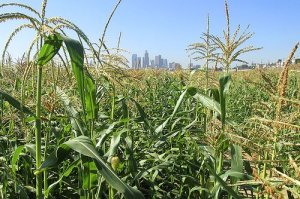
However, today’s cities are ecological wastelands devoid of any meaningful abundance of biodiversity. Such cities are not only sucking the planet dry but are also what could be considered as concrete jungles. Modern man thinks of nature as being someplace else and it is no surprise that many of us love to get out into the woods to alleviate the stress of modern urban or even suburban living. A long distance relationship with nature divorces the average city dweller from a meaningful connection to the earth and subsequently facilitates in the devastation of the planet. By introducing a productive ecological system within our cities we would achieve the vital connection with nature that many of us crave while providing ourselves with a sustainable source of food. Food that would in fact have a higher concentration of beneficial nutrients in it due to the fact that less would be lost in transportation when compared to the current agricultural methods.

Urban farms and especially community farms within our cities would benefit more than just us people. They would create habitat for a large variety of species that under existing conditions have a much harder time finding an ecological niche in the urban environment. Urban based agriculture would also greatly reduce traffic because there would be far less associated with the transport of food in our cities. This would also allow us to reduce funding for road enlargement project which in and of themselves are huge producers of carbon emissions and a drain on resources that could be used elsewhere.
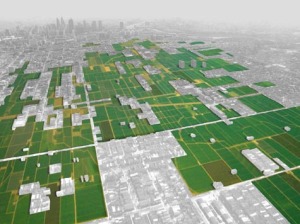
Vacant lots and dilapidated properties that could be used as farm land in Philadelphia as proposed by the Farmadelphia project
In fact the space required would be less than what we currently think of due to the abhorrent fact that much of the food produced toady is dumped at sea because it has no profit value or to keep the price of food up.
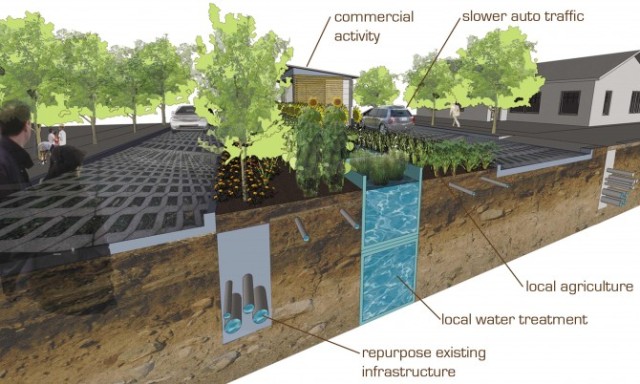
This is an example of how agriculture could be incorporated into an already in use urban setting. Note the water treatment and infrastructure capacities as well as the added space for commerce and grated roads which would allow for plant growth which would help to offset the carbon emissions produced by the city and its automobiles. This system also addresses rain water runoff in a productive manner.
There is also plenty of opportunities to incorporate food production systems into the very structure of already used parts of the city. In this way we could maximize the usefulness of every single inch of our urban or suburban environments.

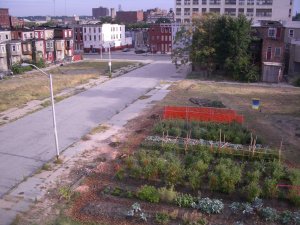
With the rampant problem of poverty, underemployment, unemployment and poor quality of education, urban agriculture could be a very useful tool to minimize these issues. Such problems especially effect people living in the inner-city and often they are minorities. These disenfranchised people often turn to the illicit drug trade for income. However, in an anarchist society or in a post-drug war era they will no longer be able to rely on such avenues to provide for their livelihoods. Without prohibition, no one would buy drugs from any street dealers when they could go to far more reliable clinics or drug shops, and in an anarchist society (one without rulership or its subsequent laws which create crimes of consent) there would be no black market at all. Without a black market gangs would loose much of their relevancy and the violence associated with them and other organized criminal elements would drop dramatically.

With the legalization of cannabis, it would remove the ability of criminal elements to control and profit from it while allowing us to tap it's great potentials.
Farming in the city would provide the vital income to keep these impoverished people afloat and alive. It could also revitalize ares affected by urban decay and transform the “ghetto” into an area of beauty and abundance. Organizations like Food Not Bombs, would do well to implement such practices into their campaigns. Instead of feeding the impoverished “rescued” food they should use such resources for composting so they can provide them with wholesome and fresher and all around better sustenance.
The youth and “unskilled” of today also have a very difficult time finding employment and growing food on a massive scale would greatly alleviate this problem. Permaculture, Masanobu Fukoka’s Natural Farming methods, no-dig gardening and other less labor intensive and higher yielding agricultural practices can also allow the elderly or people with disabilities to participate. In addition to being far less strenuous in terms of physical strain, the aforementioned methods are also great for building soil as they are not damaging to it while they also work with rather than against nature.

One of the great injustices that modern industrial agriculture causes is the loss of traditional farming skills and techniques. This is due to the fact that corporate farms displace individual farmers who cannot compete with them and as a result they must relocate to the city for income purposes. Unfortunately in the process, the traditional skills they have are lost because there are no ways for them to earn a living in the modern urban environment by utilizing their previous farming knowledge. By creating urban farms, we would prevent the loss of valuable skills and knowledge that rural farmers could provide when they migrate to the urban environment. This would also make it far easier for them to establish roots in the city after having to move there.
Maximizing a yield from the space available requires that we do not solely rely on horizontal growing space but that we also utilize the vertical element. One method of doing this is agroforestry which is an important element in permaculture. By planting beneficial or productive trees on the farming or gardening plots, we can provide shade for crops that require it and complete a satisfactory root system to keep the threat of soil erosion at bay. This method has produced very impressive results in almost every climate it has been used in. Trees also are vital to the water cycle and an abundance of them greatly helps to prevent droughts. There is also the vertical space on the sides of homes and buildings that can be taken advantage of by trellising and planting vines. Hops and grapes being ideal for such practices.
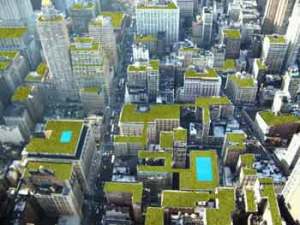
There are numerous places that can be used to grow food or other living components that help enrich the urban ecosystem. The roofs of buildings in our cities can be transformed to provide both electrical power and green spaces. This way, not only would the vacant lots and unused spaces in the city become green but the spaces that buildings occupy would as well, which would greatly increase the ecological wealth and biomass of the urban setting.
By themselves, green roofs would offset the amount of natural habitat destroyed by our buildings so when combined with trellising on their sides, any building in a city could easily provide more biomass that the original landscape could have provided for naturally. Vertical farms take this concept and would increase growing space even more. Basically vertical farms are urban high-rise buildings that could produce a massive quantity of food. Their key strength is that they take up a nominal amount of space on the ground but multiply that vertically. A building that covers one-half acre at street level can easily provide several acres of climate-controlled space vertically.

Winter itself would be far less of a problem in a food production sense if vertical farms were built and with the use of winter farming methods, like some of the ones pioneered by permaculture practitioners, combined with greenhouses in the larger of the urban farms or gardens, there wouldn’t be too much of a need to import food.

Vertical farms would also be the ideal environment for breeding plants for optimum growth in their specific cities and would provide a nice escape for the people of the city from the cold of winter. They could also provide food that could not otherwise be grown in specific regions where those plants were ill adapted for cultivation due to various factors.

In areas that do not get too cold during such periods, food production could easily be increased by using such techniques and that food could be used for trade. In the rural areas near agri-cities in winter affected regions, the surplus food produced during summer could be traded with regions that either where in the opposite hemisphere and were experiencing summer, or equatorial regions that have year round growing seasons to help supply the cities.
To add to the richness and diversity of this new urban ecosystem, the re-introduction of livestock (specifically dwarf or miniature breeds) and poultry would well round the over all effect of creating a complete and harmonious system and aid in natural, chemical and toxin free, pest control while simultaneously providing sources of high-quality, local meat, eggs and dairy.
By growing food in the city we would provide ourselves with a stronger bond not only to nature but to each other and the cities we live in. We would also create an extremely rich and diverse ecosystem that would be beneficial to our planet. By implementing such practices, we would also address one of the key problems with our ever growing global population. We can begin to achieve this now by taking direct action and creating guerrilla gardens and if we formed urban farming collectives and food cooperatives following the principles of anarchist autogestion, we could achieve this vision in our lifetimes, and possibly sooner than we think. If the anarchist movement got behind this kind of a massive project and especially if we spearheaded it, we could dramatically and positively shift the opinion of the masses regarding our ideology while allowing us the ability to show our cause in its true light.







